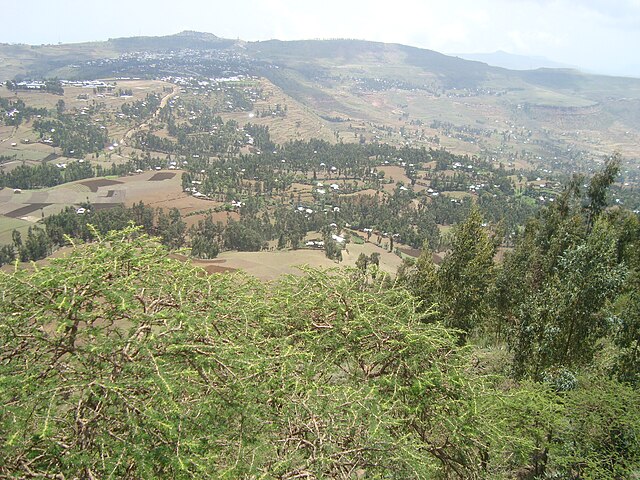Mika'el Abiy
Place in Tigray, Ethiopia From Wikipedia, the free encyclopedia
Place in Tigray, Ethiopia From Wikipedia, the free encyclopedia
Mika’el Abiy is a tabia or municipality in the Dogu’a Tembien district of the Tigray Region of Ethiopia. The tabia centre is in Megesta village, located approximately 7 km to the southeast of the woreda town Hagere Selam.
Mika’el Abiy | |
|---|---|
 Mount Gumawta dominates the Mika’el Abiy skyline | |
| Coordinates: 13°37′N 39°12′E | |
| Country | Ethiopia |
| Region | Tigray |
| Zone | Debub Misraqawi (Southeastern) |
| Woreda | Dogu’a Tembien |
| Area | |
| • Total | 33.76 km2 (13.03 sq mi) |
| Elevation | 2,320 m (7,610 ft) |
| Population (2007) | |
| • Total | 5,698 |
| • Density | 169/km2 (440/sq mi) |
| Time zone | UTC+3 (EAT) |
The tabia stretches down south of the main road towards Rubaksa, which is a wider area with several springs and traditional irrigation. The highest peak is Gumawta (2815 m a.s.l.) on the Tsatsen plateau and the lowest place Rubaksa (1920 m a.s.l.).

From the higher to the lower locations, the following geological formations are present:[1]

The main geomorphic units, with corresponding soil types are:[3][4]


As there are no permanent rivers, the presence of springs is of utmost importance for the local people. The following are the main springs in the tabia:[5]
The population lives essentially from crop farming, supplemented with off-season work in nearby towns. The land is dominated by farmlands which are clearly demarcated and are cropped every year. Hence the agricultural system is a permanent upland farming system, and the population are not nomads.[6]


The tabia centre Megesta holds a few administrative offices and some small shops. The villages close to Hagere Selam (Dingilet and Harena) have established a new settlement, at the margin of Hagere Selam, where the inhabitants benefit from the proximity of the town.[5] The main other populated places in the tabia are:[7]
|
|
Most inhabitants are Orthodox Christians. The following churches are located in the tabia:
|
|
In Megesta, there is a strong story about the Queen of Sheba who was transformed in a snake; the track of the snake is represented by a line of trees up to now. In the northern part of Harena, called Argak'a, there is a large rock of more than 50 m2 - the story goes that a certain Ilias transported it up to there.[8]
The history of the tabia is strongly confounded with the history of Tembien.
The main road Mekelle – Hagere Selam – Abiy Addi runs at the north and west of the tabia. Inhabitants mostly move on foot to Hagere Selam from where they can travel further. A rural access road links Hagere Selam to the main villages of Mika’el Abiy.
Almost all children of the tabia are schooled,[9] though in some schools there is lack of classrooms, directly related to the large intake in primary schools over the last decades.[10] Schools in the tabia include Selam Seret school.
Its mountainous nature and proximity to Mekelle makes the tabia fit for tourism.[11]
The high variability of geological formations and the rugged topography invites for geological and geographic tourism or "geotourism".[12] Geosites in the tabia include:
|
|

Trekking routes have been established in this tabia.[13] The tracks are not marked on the ground but can be followed using downloaded .GPX files.[14]
In the main villages, there are traditional beer houses (Inda Siwa), often in unique settings, which are a good place for resting and chatting with the local people. Most renown in the tabia are[5]
The facilities are very basic.[15] One may be invited to spend the night in a rural homestead or ask permission to pitch a tent. Hotels are available in Hagere Selam and Mekelle.
For more details on environment, agriculture, rural sociology, hydrology, ecology, culture, etc., see the overall page on the Dogu’a Tembien district.
Seamless Wikipedia browsing. On steroids.
Every time you click a link to Wikipedia, Wiktionary or Wikiquote in your browser's search results, it will show the modern Wikiwand interface.
Wikiwand extension is a five stars, simple, with minimum permission required to keep your browsing private, safe and transparent.